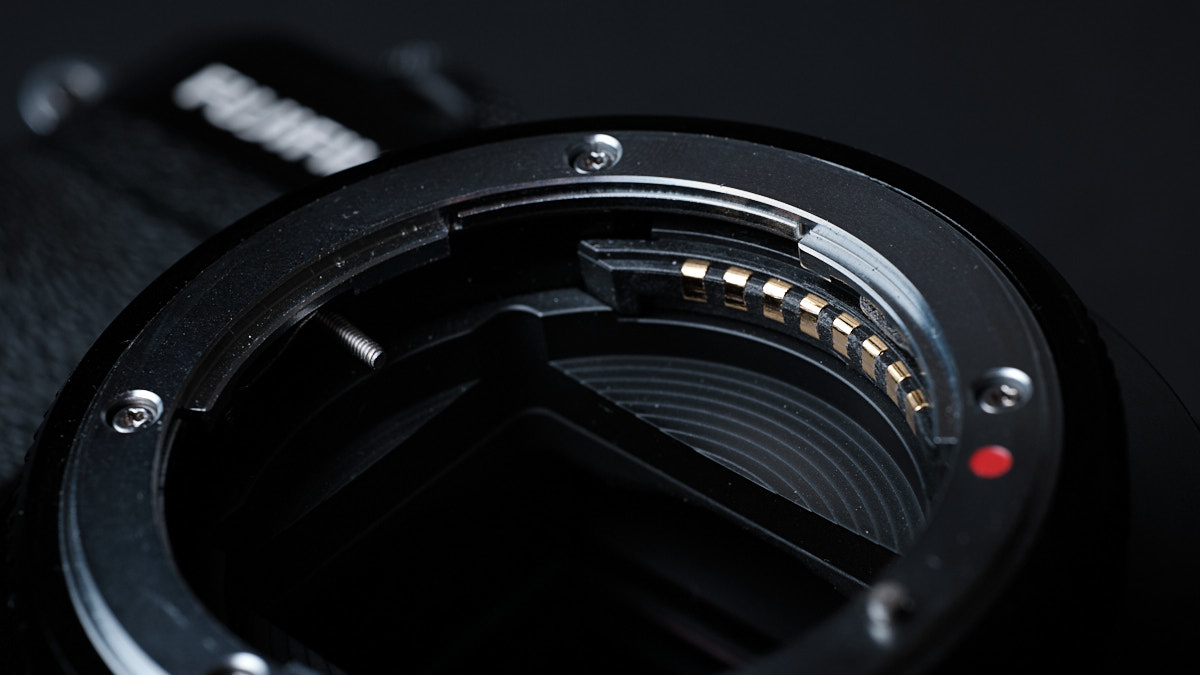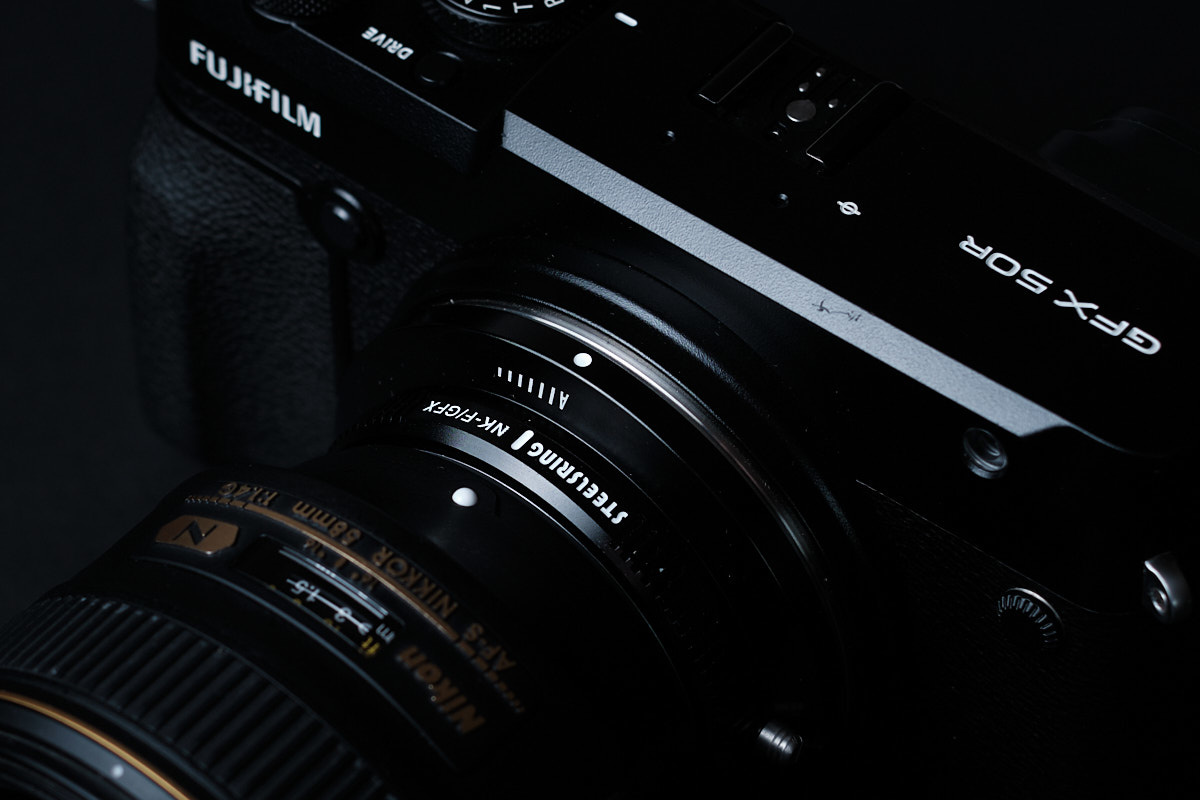For many photographers and videographers, part of the fun of having a mirrorless camera is the wide variety of lenses that can be adapted to the body due to the shorter flange distance made possible by removing the mirror. In this article, we'll be taking a look at one such adapter, the Steelsring Nikon F to Fujifilm GFX Smart Autofocus Adapter.
The decision of whether or not to adapt lenses to other cameras, especially those with different sized sensors is entirely a personal one. For me, while I own two of Fujifilm’s fine GF lenses, I do long for something a little more imperfect and fun to use for personal work. The GF 110mm f/2 has been my staple for my Tattoos of Asia project and combined with the GF 45mm f/2.8, has served me well for editorial portrait assignments. However, over the last 12 months, I’ve been experimenting with some old Nikon lenses using my Fotodiox and Zhongyi adapters.
In my experience, with many modern Nikon lenses, the focus throw is simply too short for precise focusing wide open (especially when coupled with the larger GFX sensor). So, I began looking for an autofocus option and came across Steelsring’s offering. At the time it was still in testing and I was unable to order, but after a little waiting it became available and I ordered one up. It’s not cheap and that might be a turnoff for some. However, so far it’s the only option so I decided to give it a try.
GFX 50R + 58mm f/1.4 @ f/4
Build Quality
Overall, the heft and materials used befit the price tag of this adapter, but there are a few caveats to that which bear talking about. On my copy, the Nikon mount feels far better than the Fujifilm mount. When mounting to the GFX, it is nowhere near as smooth as native lenses or Laowa offering. It doesn’t feel like too much force is required, but it doesn’t feel like you’re mounting a premium product. On the other hand, mounting a Nikon lens to the other side feels great. It’s nothing short of the experience of mounting a Nikon lens to a Nikon body. I have included a section in my recent YouTube video examining this in detail. Please check that for a more tangible look at the issue above.
https://youtu.be/oRqxakU-jbs
In terms of machining and presentation, it looks and feels like something you might buy from Nikon or Fujifilm. The overall construction of the outside is excellent. A couple of small things to note are the lens release tab and the aperture ring (we’ll talk about that below). The lens release tab is similar to those you find on the cheap mount adapters everywhere. A simple screw that can be pushed down to release the lens. While it feels solidly constructed, the presentation and dampening could match the rest of the adapter better. Having a nice machined black switch over the top of it would complete an otherwise great looking and feeling piece of equipment. When you push the lens release on a camera body, it has a spring to provide a nice feeling to that press. The addition of these would also be welcome on the Steelsring adapter.

Functionality
So, what makes the Steelsring offering "smart?" Well, two things. It is able to recognize which Nikon lens is attached by taking the data from the lens' CPU and record that as metadata in the files the GFX outputs. Also, it is able to translate between the Nikon and Fujifilm autofocus systems to allow for regular AF operation.
As mentioned on the product page, autofocus only works with modern G or E type lenses (although you can mount any F mount lens). This is a Nikon limitation as the F mount includes a screw-driven focus motor in the camera body as well. With the G type lenses, Nikon introduced focus motors into the lenses but retained backward compatibility with their older lenses. Since neither the GFX or the adapter has Nikon’s focus motor built in, only electronic control of internal focus motors is possible.

Steelsring Nikon F to Fujifilm GFX adaptor CPU contacts and Aperture Indexing tooth.
With the few lenses I have tested, autofocus works well when it does. There still seem to be a couple of bugs that stop the whole system from functioning at times, but switching the camera on and off is a quick fix for now. Autofocus is, of course, dependent on the lens. Some of Nikon’s faster-focusing formulas like the 20mm f/1.8G are snappy on the GFX system as well. In fact, this lens actually focuses faster than the native GF 110mm f/2 in my tests (CDAF). This is probably due to the lighter glass moving shorter distances. Still, this is impressive nonetheless. The Nikkor 58mm f/1.4, my favorite lens from when I used Nikon (and also my very first article here on Fstoppers!), does not fair so well. It hunts quite a bit to acquire focus at times. But, it was never known to be the fastest focusing lens on Nikon bodies anyway.
GFX 50R + Nikkor 58mm f/1.4 @ f/2
In terms of accuracy, all the lenses I’ve tested have locked on perfectly almost every time. The only missed focus I’ve had so far has been to do with the bugs I mentioned above or in situations where a lack of contrast makes even the native GF lenses struggle. Even in dim light, the Steelsring adapter is able to focus as accurately as native GF lenses. This has been great because my major frustration with the manual focus adapters I’ve used to date was focusing with large-aperture lenses. This is certainly a fix for the issues my eyes have with manual focus.
At present, the adapter only supports contrast-detect autofocus, but I’m hoping that since full communication between the body and the lens is possible that we might see phase detect implemented for the GFX 100 in an upcoming firmware update. In the meantime, the contrast-detect wobbles will be a part of even your GFX 100 experience. For a visual example of how much this affects focus and how quickly you can expect lenses to focus, please take a look at my YouTube video above.
Let’s move on to the aperture ring. This is one of the pieces to this puzzle that I feel could have used a lot of refinement before launch. At this price point, I would expect this aperture ring to feel good and work well. It certainly feels and works, but not well. The ring itself is extremely loose and too easy to knock. I found it constantly slipping while in my bag or getting knocked as I picked the camera up. A more rigid construction would go a long way towards accurate use. Also, the stops to not feel particularly accurate as they’re extremely close together and there is a lot of looseness to the ring. With the rest of the construction being so good, this is disappointing.

With complete communication available between body and lens, I feel like implementing aperture control would have been a nice touch here. With this current design, control of E-type lenses (those with magnetic apertures) is possible from the GFX body via electronic control. However, G-type lenses make use of a modernized version of Nikon’s AI system and this is not fully supported by the Steelsring adapter. It seems as though the aperture control is purely mechanical and the adapter doesn’t actually know which position it is in. At the very least, it would be nice if the adapter could send the aperture data to the camera body so a record could be kept of which aperture value was chosen. Nikon’s AI system allows for this. If this is not possible for some reason, I think I would have preferred to have a de-clicked aperture control to allow small changes.
In Conclusion
Would I recommend this despite the small issues? If you're looking for an autofocus adapter, absolutely! If autofocus is not a priority for you, then there are plenty of cheaper options out there that will allow you to mount all Nikon lenses and manual focus them to your heart's content. If you'd like to order one up for yourself, you can do so over at Steelsrings.
What I Liked
- Ability to autofocus Nikkor lenses
- Accurate and reliable focus
- Overall build quality
What I Feel Could Be Improved
- Aperture indexing
- Quality of aperture ring
- Lens release tab
- Machining of the GFX mount side











What is the projection footprint of the Nikon lens compared to the GFX sensor area?
That varies hugely from lens to lens. There are a couple of examples in the video above.
I've just updated the adapter to version 1.04 of the firmware and focusing speed with the 58f1.4 is improved as the AF algorithm does not range from each extreme on each shot, it's more intelligent. Also the Sigma 501.4 is now supported, another great lens for environmental portraits.
Face and Eye-AF modes also work apart from the FACE-ON/EYE AUTO which reverts to the manual focus point in my tests. In my low light testing with both the 58 1.4 and 85 1.4 it was hit or miss whether the face/eye AF worked. So in my view, turning it off and selecting a focus point was the faster option for portrait shooting.
Can anybody comment on the quality and glitches of this adapter when using Nikon 19mm PC on a GFX body? Many thanks!